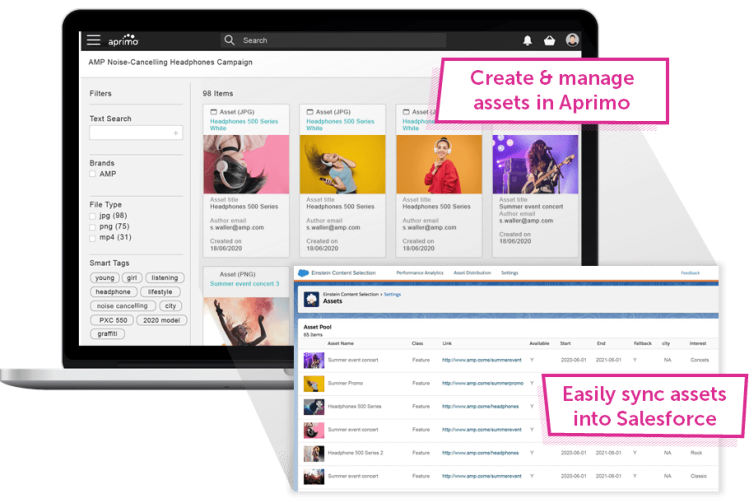Your marketing ecosystem – the connectors and integrations you use to build a multi-faceted tech stack – is the key to getting the most out of your digital asset management software investment.
DAM integrations simplify the workflow for your content ops teams. Whether you want to blame Apple, Google, Amazon, Netflix, or any one of your favorite digital experiences, we’re wired to expect convenience. It’s easier now to find whatever you want. Or better yet, get a recommendation from AI, and then take an action.
When you think about finding content to accomplish a task, shouldn’t you also expect an “Amazon level” of convenience? Sadly, for too long marketers have put up with a subpar experience and it’s had a real impact on efficiency. Most studies place the time spent looking for the right content as taking anywhere from 4-6 hours per week per employee. 4-6 hours per week!
The primary purpose of a digital asset management (DAM) solution is to centralize content that’s ready for market. But that’s just the first step.
To really drive the value of a single source of truth, end users must be able to readily and easily access the content they need. For this to happen, it’s imperative to focus on core digital asset management integrations.
Powerful DAM integrations enable you to bring approved content into the existing, everyday workflow of your end user. They connect your disparate digital ecosystems and share assets across content management systems. They also help you balance the desire of end-user convenience with brand consistency and compliance.
What is a DAM Integration?
In many ways, a DAM is only as powerful as its ability to connect to the tools you use to connect with your customers ?at the glass? or at the zero moment of truth.
DAMs centralize all your content and integrations help you get those products to market. Digital asset management systems with an open architecture and broad extensibility framework allow you to connect to different digital infrastructures across content management systems (CMS) or product information management systems (PIM), or various content authority tools, serving up the images, video, and other digital assets you need for your campaigns. This saves time, improves campaign consistency, and ensures compliance, whether brand, medical, legal, or regulatory.
In general, the most common DAM integrations fall into one of three categories:
- Content Intake
- Content Enrichment
- Content Distribution
In each of these three areas, I’ll tell you about one or two critical integrations that make your DAM the core content component of your customer experience technology.
Content Intake: DAM Integration with Adobe Creative Cloud
Without a doubt, the most common creative suite still used by designers of all content types is the Adobe Creative Cloud, including InDesign, Photoshop, and Premier. Creatives are always under pressure to meet constant deadlines. Incorporating a DAM integration that creates a more efficient work process can be a huge relief.
The most common use case is to allow a designer to pull content from your DAM directly into a Creative Cloud app and then check in the final asset to the DAM. This reduces the likelihood of error and frees up more time to focus on work.

In this scenario, a designer can access the DAM directly from the Adobe InDesign user experience.
Content Enrichment: DAM integration with PIM and Work Management
At the core of content findability and usage, are metadata and taxonomy.
Metadata and taxonomy determine where a file is located and how easily it can be found and used in a campaign. Today, most of the work of finding assets is manual. Adding metadata to an asset is also largely manual. This task falls to DAM librarians, content creators, or content originators depending on a company’s preference. Human variance and error can also cause inconsistencies in metadata and taxonomy.
Product Information Management (PIM) and work management tools are key. Companies have found that they contain a vast amount of critical, non-visual data that can be used to enrich an asset.
A sustainable strategy is to integrate the DAM with other systems that enable the automatic flow and enrichment of an asset. This means that data about a product stored in a Product Information Management (PIM) tool or campaign information stored in a work management solution will become associated with the asset automatically, removing the potential for pesky human error. Adding a DAM for inRiver, a popular PIM solution is one approach many marketing teams pursue.
Content Distribution: Your Marketing Cloud and Web CMS
Once content becomes findable, it’s critical that it finds its way into the market!
By focusing your efforts on your main Marketing Cloud and your Web CMS, you can cover many of the most content-heavy channels you’ll encounter. Your channel owners will then be able to select from already-approved content within their solution’s existing interface. Say hello to faster speed-to-market and improved consistency across brand assets.
The most common examples include integrating DAM for Salesforce Marketing Cloud and something like DAM for Optimizely, both widely regarded as leaders in their field.

Create and manage assets with Aprimo DAM and send them to Salesforce Marketing Cloud.
Integrating DAM into these key capabilities will help you build out your content operations capability. Most cloud-based systems already offer integrations or APIs, so you can connect platforms without the need for expensive custom integrations.
But before you think integrations are simply a ?nice to have,? remember: integrations among systems make your marketing team nimbler and more effective at meeting customer needs.
After all, content is what drives your customer experience.
?Content encompasses everything communicated by a brand to an audience, whether it is internal or external. Marketing leaders must plan their content operations ecosystem to be adaptable for ingesting, organizing and managing all of these content types? ? Gartner, The Future of Content Operations: How to Deliver Marketing in a Changing World
To learn about other integrations, including those with video delivery and social media, check out the Aprimo Marketplace and see what integrations your peers have put into practice!



